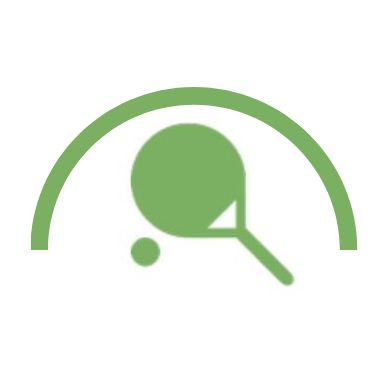Higher Quality, Longer Lasting, Better Looking Padel Court Canopies for Clubs That Care
Higher Quality, Longer Lasting, Better Looking Padel Court Canopies for Clubs That Care
Higher Quality, Longer Lasting, Better Looking Padel Court Canopies for Clubs That Care
As padel continues to boom in the UK, perfectly good courts from European countries are being paired either with canopies designed for regions that don’t have to think about snow, and British Standards, or with structures designed for temporary warehousing, large marquees or garden centres.
We are working with architects, clubs and padel court installers across the UK on designs that are fit for purpose, fully compliant and built to last.
- Looking for a padel court cover to last as long as the court?
- Want to avoid high maintenance cost on your padel court roof?
- Care about how your padel courts look?
- Ruled out aluminium frames, marquee fabric and garden centre style structures?
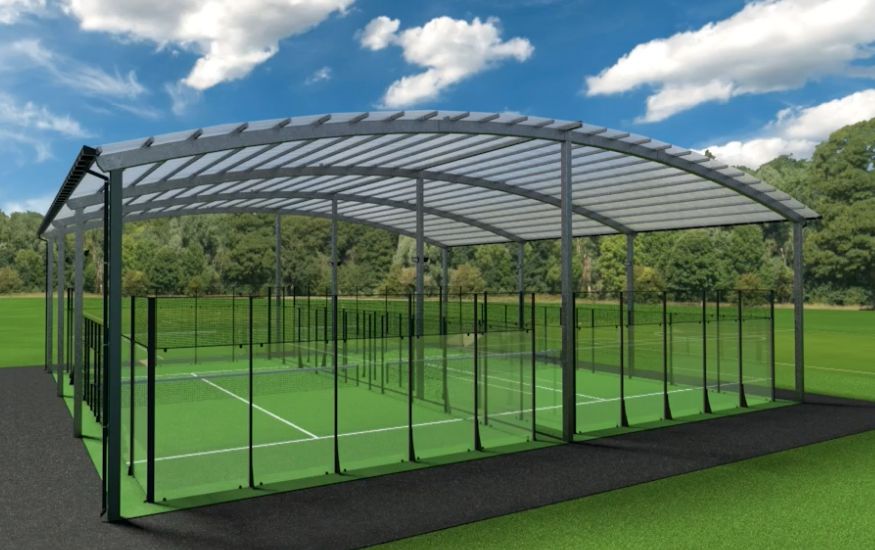
Please call us today on 01743 444100
Expert Team
With over 40 years of experience, you know you can trust our team to deliver the best results.
High-Quality Covers
We only use the highest-quality of materials and latest processes to create industry-leading structures.
Keep On Playing
Our effective covers mean you can always use your padel courts, come rain or shine.
Get a quick proposal

Padel: The Game, The Court Design, The Rules – Everything You Need To Know About This Booming Sport
Padel is a fast-paced and increasingly popular racquet sport.
At first glance, padel appears to be very similar to badminton or tennis. And while like tennis, you typically play in doubles and the scoring is the same, there’s a marked difference between the two. You play padel on an enclosed court roughly 25% smaller than the size of a tennis court with balls very similar to tennis balls, but they have less pressure.
Unlike tennis, padel players can hit the ball off the walls surrounding the court, which invokes a very different, faster-paced game than traditional tennis.
Where Was Padel Invented?
The sport of padel first began in Mexico in the late ’60s. It’s currently the most popular sport in Spain, Mexico, Andorra, and Argentina. Padel is now starting to spread rapidly across Europe and other continents and is becoming increasingly popular in countries like the UK.
In response to padel’s rise in success, a pro padel tour (PPT) began in 2005. This pro tour came about because of an agreement between padel game manufacturers and padel clubs who both had the goal of making padel more competitive.
Who Invented Padel?
Enrique Corcuera invented Padel in 1969, México.
Why Is Padel So Popular?
Padel is a fast-paced sport. The speed tactical changes between players and different ball exchanges’ speed contribute to the sport’s incredible appeal.
Because the court is smaller and competitors are so close, it’s effortless for the players to interact with each other, making it a very sociable game.
In padel, you don’t need to have the technical ability of a real pro. Even people with moderate skills can start playing straight away. Additionally, unlike other ball sports, padel offers more rewards for your efforts because it’s not as technically challenging as other sports like tennis. Try out padel for yourself, and when you feel the rush, you too will see why padel is so popular.
The game of padel is one of the easiest ball games for beginners to pick up and arguably the most rewarding. Anyone can learn padel in less than an hour.
Where is Padel popular?
Surprisingly, the little known, but soon to be infamous, sport of padel is popular in several countries and is growing in popularity. At the time of writing, this is what we know about who plays padel and where:
Which countries play padel?
According to The Padel Federation, the following countries are playing padel:
- Argentina
- Australia
- Austria
- Belgium
- Brazil
- Canada
- Chile
- France
- Germany
- India
- Italy
- Mexico
- Paraguay
- Portugal
- Spain
- Switzerland
- The United Kingdom
- The United States
- Uruguay
- Finland
Where is Padel played in the UK?
We’ve put together a list of all of the current padel courts in the UK so that you can easily find your nearest court and start playing. Click here to see the full list of padel courts in the UK.

Padel: How Many Players Can Play The Game?
Most Padel games and competitions involve two players per team.
Can you play Padel 1 vs 1?
Yes, you can play singles in padel, though one vs one play in padel is difficult due to the game’s speed.
Padel: How Is It Played?
In padel, you need to win two out of three sets to win a match. To do so, players must work as a team. You’ll play three sets in total. Each set consists of six games. As the court is much smaller than a tennis court, players are closer together and must communicate well to remain successful.
The point system in padel is just like tennis: 15, 30, 40 and game. If the score ties at 40-40, it’s called ‘deuce’. The first player to get two clear points wins the game.
To win a singles set, one player needs to win six games and claim two clear rounds. If the game ties at six games apiece, a tiebreak ensues. The first player to get seven points wins. You can accomplish this with a two-point lead. If a singles game goes on without a clear winner, another tie break begins with the winner being the first player to claim an additional two points over his opponent.
What Are The Padel Rules?
Playing Padel can seem complicated at first glance, but it generally isn’t. If you’re wondering what are the rules to padel, then you may be surprised to learn that they simple.
One basic rule is that when you send a ball to a player, it must bounce once on the ground before your opponents can hit it. Another rule relates to times when the ball bounces off a wall instead of the floor – opponents can only send the ball back over the net after it bounces off a wall, hence why it’s an enjoyable game!
According to the International Padel Federation (IPF), there are 17 official padel rules. There are also conduct, etiquette and equipment standards that you must meet which maintains the game’s integrity and promotes fair play.
Who Is The IPF In Padel?
The International Padel Federation governs the game of padel. Along with its many other tasks, the IPF organises competitions, advises players on the rules of padel including padel court design and dimensions, game etiquette and bat and ball requirements.
The IPF has the ultimate authority to create and change the rules and to do so, they evaluate the game regularly and create new rules when necessary.
What Are The International Padel Federation Game Rules?
The IPF list 17 padel game rules in total, along with specific court and etiquette requirements. Here are the seventeen rules of padel according to the IPF.
Padel Rule 1: Courts
Padel courts should meet the standards shown below in the section ‘padel courts’.
Padel Rule 2: Time Keeping
The umpire will give your opponent a walkover, a free win, if you do not show up on time. But there are some exceptions to the rule. If you are late due to something out of your control (a force majeure), the umpire will wait for any amount of time he or she thinks is reasonable.
Padel Rule 3: Player Positions
In a doubles match, there are two teams, each composed of two players. The serving team stays on one side of the net, and the receiving team stays on the opposite side of the net.
The one player who serves (puts the ball in play) should have the best view of the net. At the same time, the opposing team’s receiving partner is always diagonal to the server.
All players must serve and receive according to the regulations. Players can move around anywhere on their side of the court, but they cannot be outside the court.
Padel Rule 4: Choice of Sides and Service
Sides and services are often a source of tension during a padel match between two teams. Who serves first? Which side of the court do the players want to be on? It can be pretty chaotic. The fairest and efficient way to handle this is to flip a coin to make a decision.
The winning team will choose one of three options:
- Which team serves first.
- Which side of the court they’ll play for the first game.
Or
- They hand over the choice to their opposing team.
Once the ‘coin winning team’ makes their choice, the opposing team has the opportunity to choose whichever option is remaining.
Padel Rule 5: Switching Sides
Players must switch sides (ends) after the first, third, and every subsequent odd game of the set. In a “tiebreak” (also known as a “set tiebreaker”) players change ends after every six points.
Padel Rule 6: Service
All points begin with service. If the first service is invalid, the server must be allowed a second chance to serve. For service to be valid, it must meet the following requirements.
a) At the start of service, servers must stand behind the service line. Both feet must remain there until the ball has been served.
b) The server must bounce the ball on the ground within the service box they inhabit to carry out the serve.
c) The server may not touch the service line with their feet nor the imaginary line running parallel with it.
d) At the time of hitting the ball, it should be at, or below waist-high and the player should have at least one foot on the ground.
e) The server hits the ball, which travels across the net toward the receiving box. They must hit it from their right side of the court, and it must bounce within the lines that define the receiver’s side of the court.
f) While serving, a player may not walk, run, or jump. Only minimal amounts of foot movement are acceptable.
g) A serve occurs when the ball contacts the racquet, or in an attempt to hit the ball before it hits the ground.
h) If service accidentally occurs from the wrong side, you’ll need to correct your error as soon as you realise. All points remain valid in this situation, but if there is a fault on the first service, the umpire should consider it.
i) Before each set, the players should settle which one of them will serve first. Once they’ve determined it, they must stick with that decision for the rest of the set.
j) When a player serves out of turn, the player who should have served must do so as soon as the mistake is recognised. Points won before the error are valid.
k) The server does not serve the player until the player is ready. However, the receiving player adapts to the server’s rhythm, and when the server is ready to serve, so is the receiving player.
l) A “not ready” call is only valid if nobody attempts to return the serve. And if it’s apparent that the receiver was not ready, you cannot call a “fault”.
Padel Rule 7: Service Fault
There are only six circumstances in which a service fault can occur:
- If the server infringes the rule 6 (a – f).
- The server misses an attempt to hit the ball.
- The ball lands (bounces) outside the lines of the receiver’s box.
- The ball hits the server or his fellow team player including anything they’re wearing or carrying.
- If after bouncing in the receiver’s box, the ball touches the fence around the court before the second bounce.
- In a court without a safety zone, if the ball bounces into the receiver’s box and then straight through the court gates when no out-of-court play is authorised.
Padel Rule 8: Return of Serve
The player receiving has to wait for the ball to bounce within their service box and hit it before it bounces for a second time.
Padel Rule 9: Let and Net Service
A service is ‘net’ if it meets the following conditions:
‘Net’ refers to moments in the game where the ball hits the net.
- The ball lands in the receiver’s service box after touching the net or the supporting posts, as long as it does not touch the metallic fence before the second bounce.
- If the ball hits a player, the net or posts, or player’s article during play.
A service is ‘let’ if it meets the following conditions
- Service occurs when the receiver isn’t ready.
Padel Rule 10: Repetition or Let Point
Point disputes become a ‘let’ when:
- The ball splits during play
- Anything not part of the game invades the court area.
- The match experiences any unexpected interruption, and the interruption is not due to player error.
Players must inform the umpire immediately if they encounter a ‘let’ situation the umpire determines if the let is valid.
Failure to notify the umpire immediately cancels the players right to the ‘let’ and if the umpire determines the let invalid, and the player loses the point.
Padel Rule 11: Interference
Interference is when a player deliberately or involuntary influences an opponent’s shot.
An umpire shall award a point for the opponent if there is deliberate interference. If the interference occurs unintentionally, the umpire shall call a “let” and repeat the point.
Padel Rule 12: Ball In-Play
A ball is in play when:
- Players hit the ball back and forth between each pair of players.
- The ball is ‘in-play’ starting from when the ball bounces on a player’s side of the court, and then until it bounces again or a let occurs.
- If the ball hits anything on your opponent’s side of the net after bouncing on your side, you must return that ball before it bounces again.
Padel Rule 13: Lost Points
Players will lose a point if:
- Any players touch the net, posts, or any of their opponent’s equipment while the ball is in play.
- The ball bounces twice before returning.
- If the ball exceeds the marked limit of the court or goes through the gate after bouncing.
- If a player hits the ball before it clears the net.
- Upon return of the ball, if it hits the walls or court before bouncing.
- If the player performs a double hit (hits the ball twice).
- If the ball touches their opposing team members or their clothing after hitting the ball.
- If after being hit by the opposing team, the ball hits the players or their clothing.
- If the ball touches the player’s side of the court after they’ve hit it.
- If a player throws a racket to hit the ball.
- If any player jumps the net while the game is in play.
- If both players hit the ball simultaneously or consecutively (only one team member can play the ball at any time).
Padel Rule 14: Correct Return
The return is correct if after a player hits the ball it:
- Touches either one of the opposing team’s players, body, clothing, or racket. Or, after the hit, the opposing team volleys the ball.
- Hit’s the player’s own court wall before bouncing into the opponent’s court or bounces straight into the opponent’s court.
- Hits the walls or the metallic fence after it bounces into the opponent’s court.
- Hits any object not related to the court including lights, ceiling or items on the ground like another ball due to the force and direction the player used to hit the ball.
- Lands in the opponent’s court after touching the net or net posts.
- The ball bounces into the opposition’s court but then goes back into the server’s court where the opposition hits it.
- If the player scoops or pushes the ball – and the player has not hit the ball twice, and if the ball’s exit from the racket occurs as it would usually (with little variation).
- The hits a corner of the opponent’s court (where the wall joins the ground).
Padel Rule 15: Point Won
A point is won if after bouncing in the opponent’s court it:
- Goes through, or gets stuck in a hole in the metallic fence.
- Gets stuck on the top of the court’s wall.
Padel Rule 16: Authorised Out Of Court Play
Padel players can leave the court to play the ball if the court meets the conditions required to establish a court safety area and out-of-court play.
Padel Rule 17: Ball Changing
In organised padel competitions the organisers must announce in advance:
- The balls brand and model.
- The number of balls will be available for use in the match.
- If there’s a ‘ball policy’ and what it is.
What Are The Official International Padel Federation (IPF) Padel Court Design Requirements?
Padel is played in a walled-in court which is only about one-third the size of a tennis court. A padel court’s playing surface is 20m x 10m. Padel courts are much smaller than a tennis court, but it has nets — like tennis.
To meet the FIP requirements and create an authorised padel court, your padel court must have the following criteria.
What Are The Official Padel Court Design Dimensions?
The dimensions in this section of the padel court design details reflect the size of the actual court players play on. It doesn’t factor for the sides, ends and safety areas. However, you’ll find that information further on in this article.
Padel Court Design: Court Dimensions
- The padel court’s height must be 6 metres for older facilities and 8 metres for new facilities.
Note: There can be no obstructions in this area. Obstacles include lighting, heating, air conditioning etc.
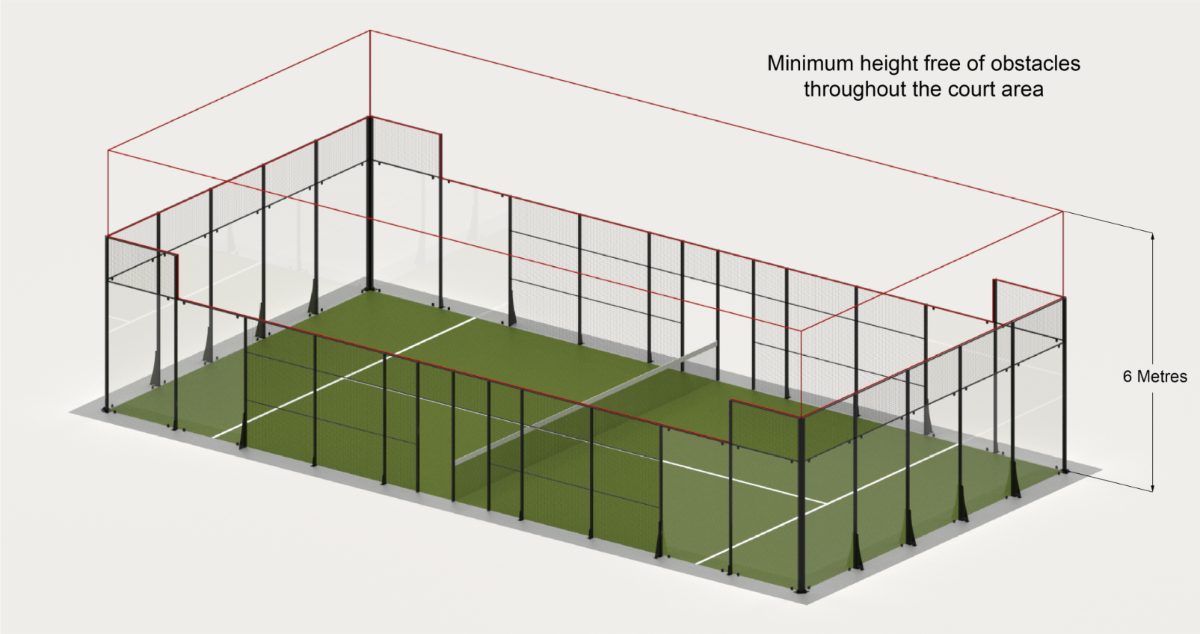
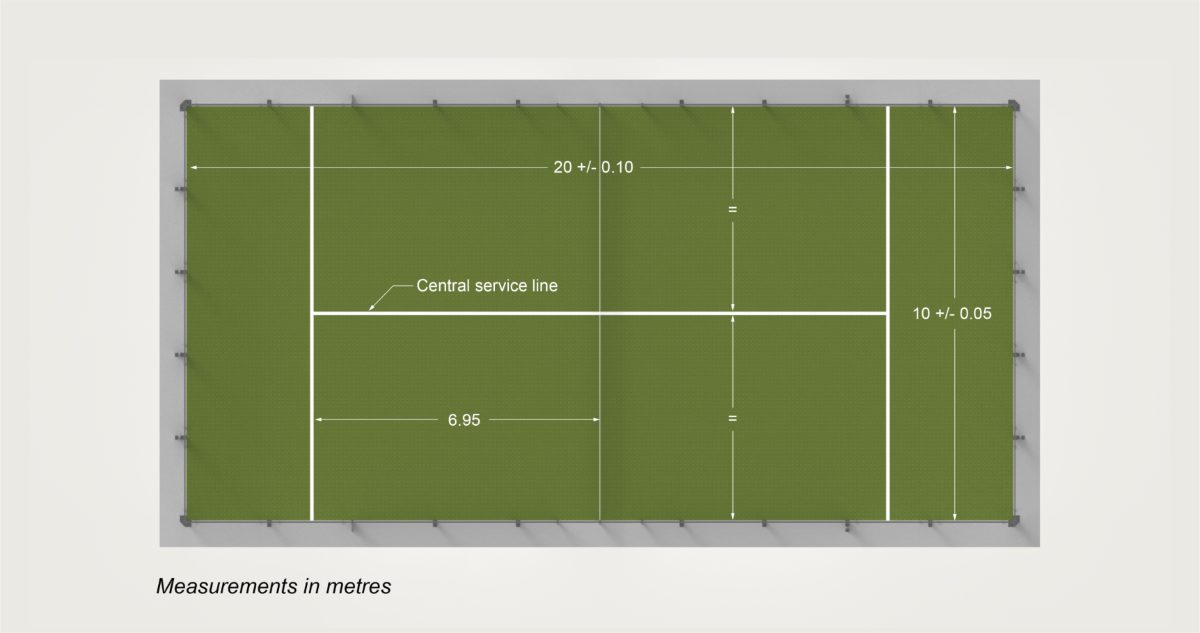
Padel Court Design: Line placement
- Service lines: Run parallel to and are 6.95 metres from the net (which divides the court).
- The central service line divides the area between the net and the service line and extends 20 cm beyond the service line at a 90-degree angle from the service line (perpendicular).
- Line layout: The divisions on the court must be symmetrical – without error.
- Line width: All lines must be 5cm wide.
- Line colour: The lines should ideally be black or white to contrast with the court’s surface colour.
Padel Court Design: Enclosure Requirements
Each Padel court needs to be enclosed entirely, though there doesn’t have to be a ceiling on the court. Ends and sides determine the ‘enclosure’ structure. Ends are the shorter sides of the rectangle, and the sides are the longer sides, all measurements are inside measurements.
- Ends must be 10 metres in length
- Sides must be 20 metres in length
Padel Court Design: Official Requirements For Ends and Sides
All areas and joins in the enclosure require materials that allow a ‘uniform bounce of the ball’.
Ends – You can use metal fencing to enclose your padel court ends – which is a standard feature for outdoor padel ball court designs. Metal fences don’t often allow for a consistent ball bounce. In which case the following will apply:
The ends’ total height should be 4 metres, of which 3 metres from the ground up should be a wall. You can use any material, solid or transparent like brick or glass. The last metre should be a metallic fence.
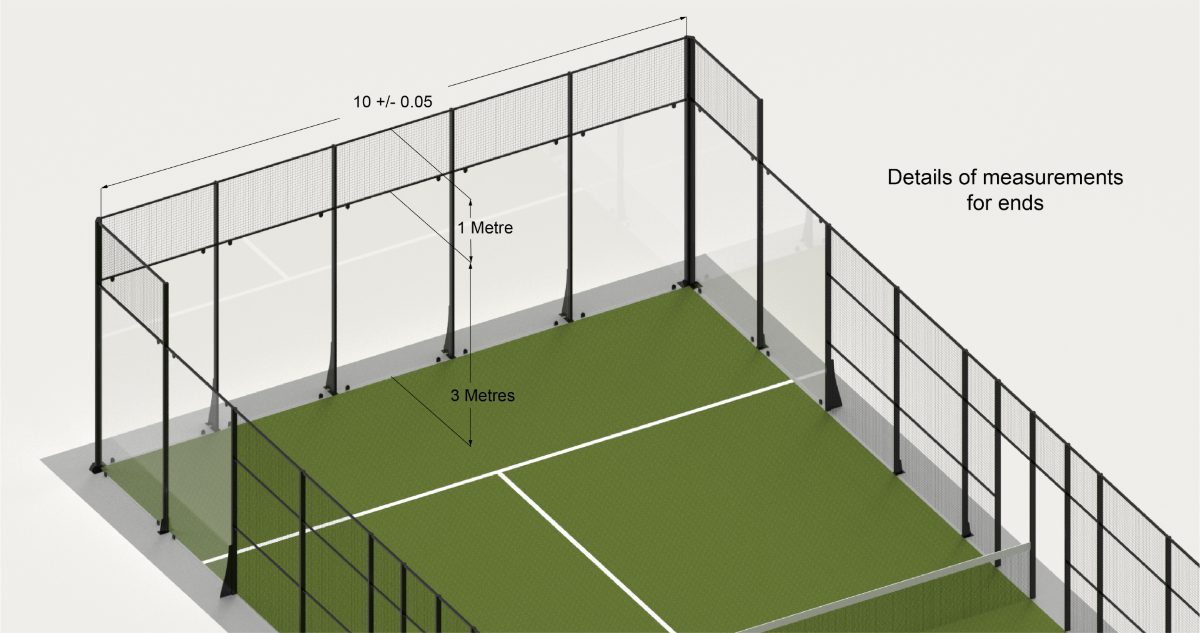
Sides – You have two options according to IPF requirements when considering your padel court enclosure sides.
You must choose from:
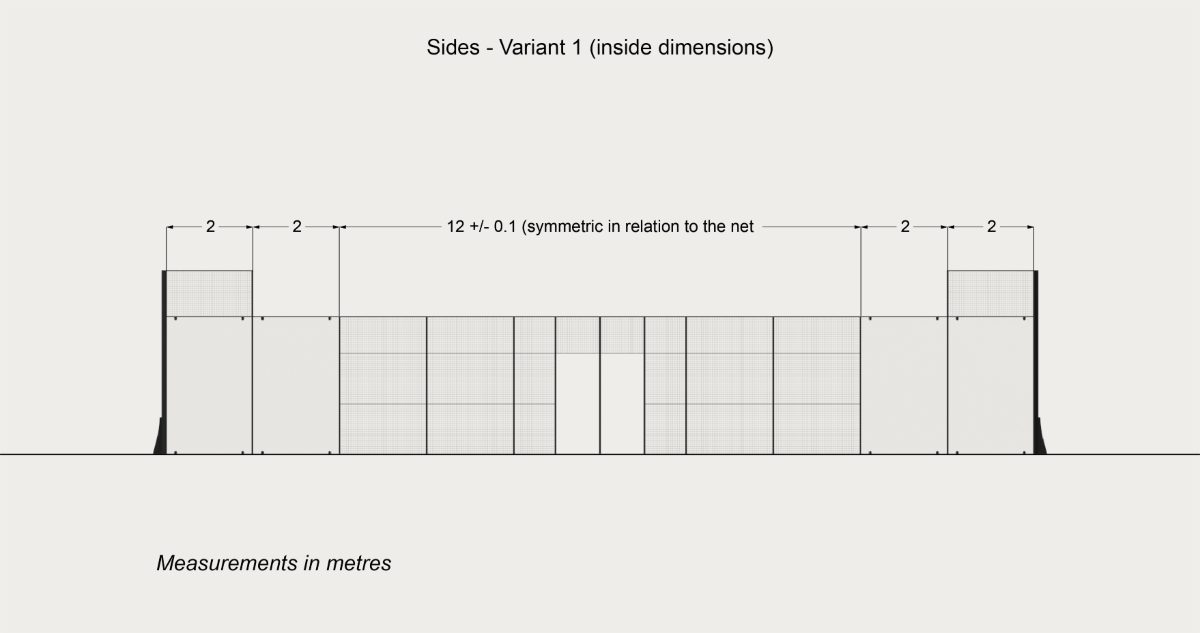
Option 1
A stepped wall at both ends with metallic fencing along the sides.
The fencing also steps up with the wall, with one metre of fence at the top of the step. The centre part of the enclosure is metallic fencing.
The fence’s height on the stepped wall (not including the ends) remains the same height as the fencing along the sides where there is no wall.
Measurements:
- First step: 3 x 2 metres (hxl)
- Second step: 2×2 metres (hxl)
- One metre (h) of fencing sits on the top of the steps
- Fencing along the centre of the sides: 16 metres
- Fencing and wall distance from the centre to the end: 4 metres
- Centre fencing height: 3 metres
Option 2
The second option is similar to the first, but the fencing height is 4 metres in the centre and 2 metres on the first step, creating a uniform finish height for the entire enclosure.
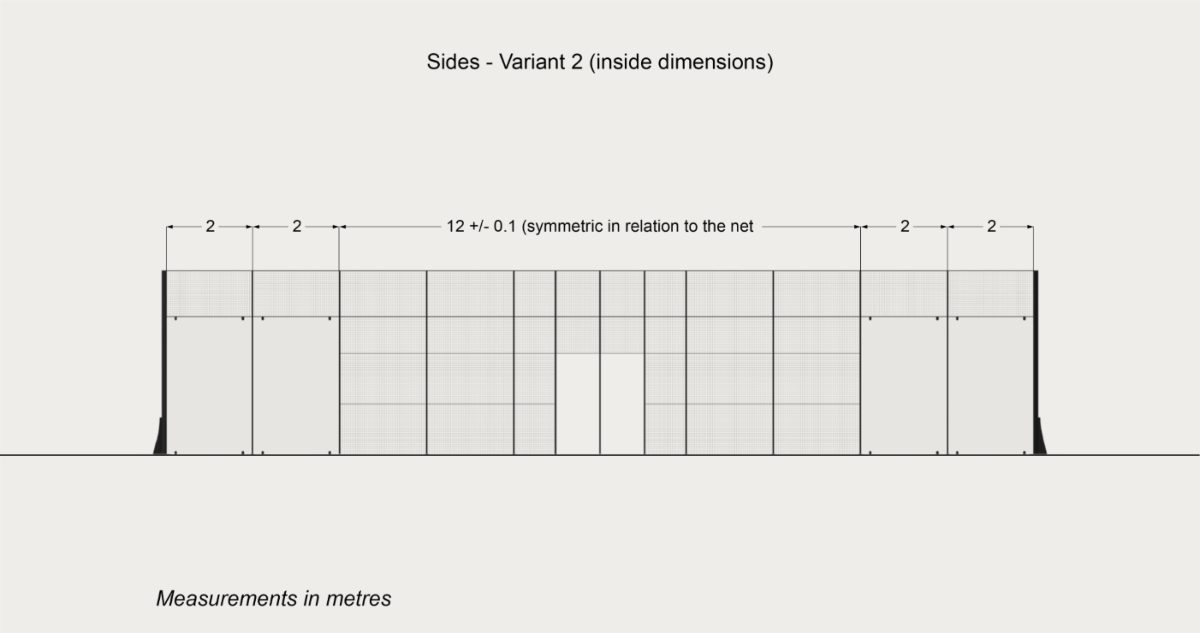
Padel Court Design: Official Enclosure Materials and Fixing Requirements
Fixings:
- You should align the metallic fencing with the inner side of the wall.
- If you fix the metallic fencing to a frame, the top part must be free of obstructions that are not part of the fencing.
Materials:
- Walls can feature any type of material (transparent or opaque), but they must have a uniform, hard and smooth surface suitable for body contact and bouncing or sliding balls.
- Glass walls must comply with your country’s standards for plate or tempered glass.
Padel Court Design: Official Metallic Fencing Requirements
- All fencing must incorporate twisted or soldered squares or rhomboids.
- The diagonal measurement of the rhomboids and squares must be between 5cm to 7.08cm.
- The IPF recommends a wire thickness of 1.6mm to 3mm.
- There should be a maximum tension of 4mm to allow the ball to bounce.
- You must protect all soldering on either side to avoid physical harm to people, clothing or objects.
- If you choose not to interlace the soldered mesh, you must only use squares with horizontal threads on the inside and vertical on the outside.
- If the fence is twisted, you must position the torsion on the outside and protect it.
- There should be no sharp or pointed edges anywhere on the fencing, including at the seams or joins.
- All fencing must provide a flat, uniform surface.
Padel Court Design: Wall Colours
Coloured walls should include one uniform colour only. The IPF prefers blue, green or terracotta colours but they don’t require them.
The walls should be a contrasting colour to the colour of the floor.
IPF regulations allow for the inclusion of a logo either printed or painted on one wall only. The logo should not include colours or dimensions that could jeopardise the player’s vision during the game.
What Are IPF’s Padel Court Net Requirements?
- The net must be 10 metres long, 0.88 centre height, and 0.92 at the ends.
- Padel nets must have a tolerance of 0.005 metres maximum.
- You should suspend all nets from two lateral posts or any part of the court structure that allows for accurate tension and suspension.
- Suspension posts must have a maximum height of 1.05 metres.
- You should only use circular or square with rounded edges.
- The posts positioning should align with the lateral limits of the court.
- Cable tension mechanisms must not pose a risk of loosening unexpectedly (or harming the players).
- The net must feature a white strip which holds the tension cable beneath. The strip’s depth must measure between 5.0 and 6.3cm when the tension cable is in place.
- You may also use the white strip for advertising and incorporate an additional strip up to 9 cm.
- The net must extend so that it fills the space between the posts and the court surface. There should be no spaces, but the net should not be tense.
Surface Materials Required For A Padel Court
A Padel court can incorporate a variety of materials. The most common surface material is cement, which usually pairs very well with synthetic or artificial grass.
The FIP states that a padel court surface must be one uniform colour. Preferred colours are terracotta or blue or green, and they should not match the wall colours.
You’ll meet the official padel court surface requirements if you use any of the following surface materials:
- Porous concrete
- Cement
- Artificial grass
- Any other synthetic or natural material that prevents water accumulation and allows for a uniform bounce of the ball.
There are specific requirements for surfaces without drainage, friction and impact absorption.
Such as:
- Drainage: The maximum evacuation slope must run from the centre of the court toward the outer edges and must slope at 1%. A 0% slope is acceptable in non-draining surfaces.
- Compliance: All artificial grass and synthetic sports surfaces must conform to the UNE 41958 IN standards or similar standards for the relevant country.
- Impact absorption: For artificial grass – (Force reduction) → RF ≥ 20%.
- Friction: For artificial grass – → 0,4 ≤ µ ≤ 0,8.
- Vertical Ball Bounce: For artificial grass and synthetic surfaces – → ≥80%.
- Sand Refill: For artificial grass – → SiO2 ≥ 96% CaO ≤ 3% Rounded edges Granulometry: 80% weight Ø 16 mm-1.25 mm Visible fibre length 2mm-3mm → Artificial grass
Padel Court Design: Padel Court Access Requirements
Court access should be on either one or both of the lateral sides of the enclosure. They must be symmetric with the padel court’s centre, and you can choose whether you want to include a door or not.
Access Dimensions
- Single Access: The opening should be 1.05 x 2.00 metres minimum and 2.00 x 2.20m maximum.
- Double Access: The side openings must be 0.72 x 2.00m minimum and 1.00 x 2.20m maximum.
Note: public padel courts must comply with access regulations for disabled people. Handles on existing doors must not protrude on the courtside.
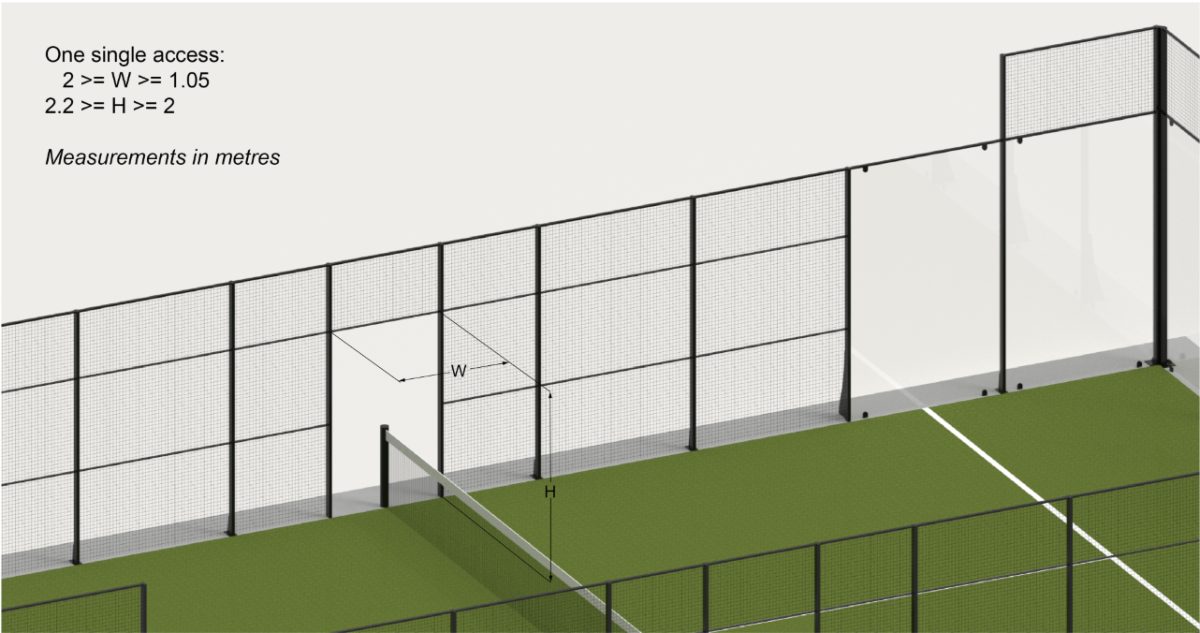

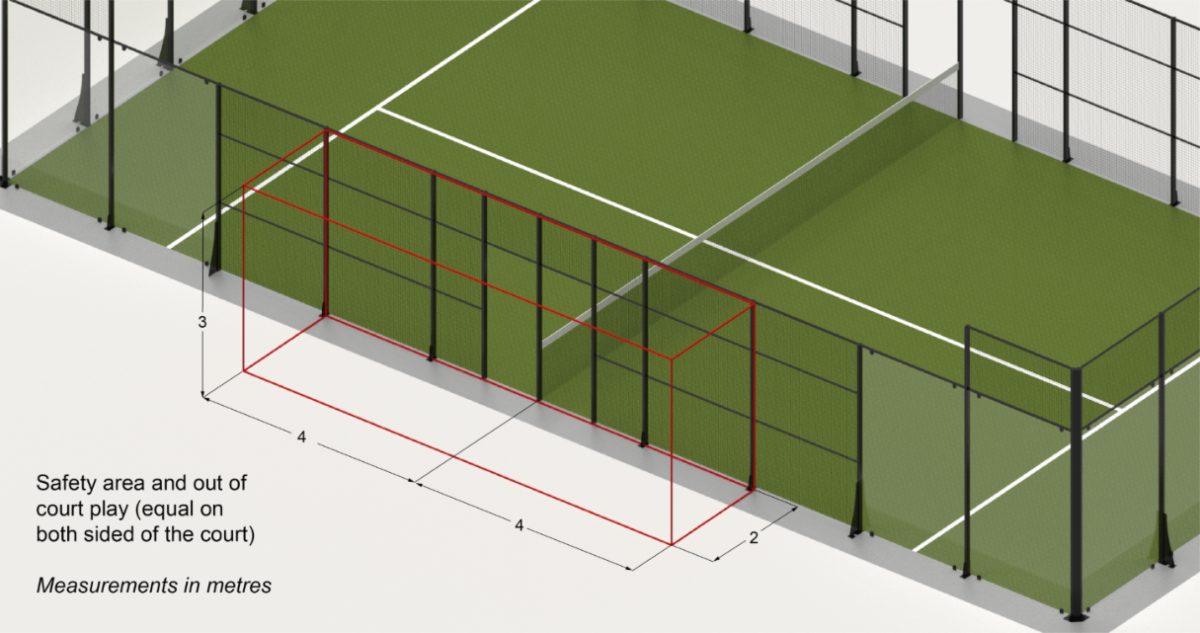
Padel Court Safety Area And Out Of Court Play Official Requirements
If you intend to incorporate out of court play (see rule 16). You’ll need to install two access points and meet the following requirements:
- There should be no obstacles outside the court within an area of 2 x 4 x 3 metres (width, length and height).
- You’ll need to protect all three sides of the court access with a product to cushion player contact, which should be no less than 2cm thick.
- The protection should be fixed firmly enough to guarantee it will hold up to its job during the game – for player protection and to eliminate game interference should the protection project onto the court.
Padel Court Illumination
- All lighting must comply with the European Union: EN 12193 sports facility illumination standards (or the appropriate standards for your country).
- The lighting position must not negatively influence the vision of the players, umpires or audience and should be uniform.
- You must position all light poles outside the court. If you need to place the light poles inside the safety area, you cannot play out of court games on the court.
- The lights’ minimal altitude (from the ground to the bottom of the projectors should be 6 metres. However, you can install lighting at different heights outside the court enclosure.
If you plan to hold televised competitions at your padel court, you’ll need a vertical illumination level of 1000 lux, which could increase depending on the object’s distance from the camera.

Padel Court Covers
It’s no surprise that the official padel tennis court design requirements are precise, they’re necessary to maintain the game’s professionalism and integrity. One area where the IPA doesn’t have requirements is when it comes to your padel court cover (which is also frequently known as a padel court shelter, or padel court canopy).
What Are Padel Court Shelters?
Padel court design can include shelters for outdoor courts or indoor courts – they can sit under a padel court shelter, canopy or in the open air. These padel court shelters can cover a single court or several courts with audiences’ facilities to watch the game.
Many of which can incorporate all the necessary heating, lighting just like a traditional brick building can.
What Are Padel Court Covers?
On the other hand, you may require a simple padel court cover that shields your court(s) from wind or rain but is open to the elements (or even has a retractable roof!).
Materials frequently used in padel court shelters are often steel or aluminium frames, polycarbonate roofing and side infills that can incorporate windows, doors, or shutters.
For padel court covers or padel court canopies you may encounter aluminium or steel frames with a fabric (waterproof and UV proof) in a teepee style structure or a series of large shade sails for a more ‘open’ air padel court cover.
Want to know more?
Get in touch with our expert team today to find out more.
